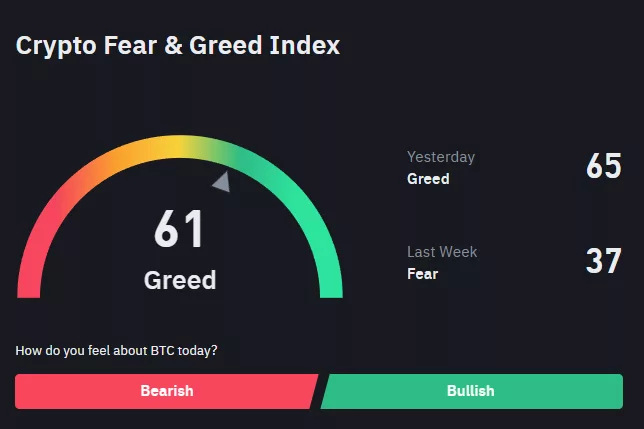Hello, community! Very few enthusiasts invest in cryptocurrency purely for the blockchain technology behind it. The main motivation is to make money. But the market doesn’t always side with the investor, swinging from wild bull runs to deep bear phases. And if you don’t fully understand what these animal terms mean — this article is for you.
Today, we’ll explain in simple terms what bull and bear markets are, how investor fear and greed influence them, and when it might be the best time to jump into crypto.
But before we start, don’t forget to check out our recent article on the phenomenon of Bitcoin dominance. Highly recommended!
What is fear and greed?
Let’s start with the most important factor — sentiment. Market sentiment defines the direction things will go: up or down.
Although the Fear & Greed Index mainly reflects sentiment, it’s actually based on several factors:
- Trading volumes
- Investor and trader sentiment
- Overall market volatility, etc.
The Fear & Greed Index is measured from 0 to 100. You can find it on multiple exchanges — including Binance.

The lower the score — the greater the fear. From 50 upwards, the market enters the “greed” zone. But what does that actually mean?
When the market is in a fear state, most investors start panic-selling their assets. Many factors can cause this, but once selling kicks in, prices begin to fall. The whole market turns red, everything drops, and your $1000 in PEPE might become $300 (never, EVER invest that much in memecoins, but hey — not financial advice).
When the market shows high greed, investors don’t want to sell their assets. This causes prices to rise due to a sort of scarcity effect. The greed phase kicks in when assets start gaining value fast. Investors hold their coins tightly rather than putting them up for sale.
Smart investors do this: buy during extreme fear, sell during high greed. That’s the oversimplified strategy — there are many finer details, of course.
What is a bull market?
The Fear & Greed Index can also indicate what phase the market is currently in. One such phase is the bull market — or bull run. This is when the bulls take over, and prices start rising consistently over time.
The bull run is what every retail investor dreams of. It’s the time when asset prices steadily climb, offering perfect selling opportunities. But newcomers often get caught at the peak, buying in when coins are at all-time highs (ATH). Still — only those who do nothing make no mistakes, right?
Typical signs of a bull market:
- Optimism dominates the market. Investors expect prices to keep rising and don’t rush to sell — greed increases.
- Not just Bitcoin rises — altcoins do too. Alt seasons are basically bull runs focused on alts, drawing liquidity away from BTC.
- Bull markets create positive news cycles. More retail investors enter the space, pushing prices even higher.
- Institutional interest grows. Big companies pour money into crypto, seeing the profit potential.
- During bull runs, coins break records and set new all-time highs (ATH).
Almost everyone waits for the bull market to cash in — it’s when assets can 10x or more in value.
The only ones who might prefer otherwise are those shorting crypto on futures. But that’s a whole other topic. These traders eagerly await a full-on bear market.
What is a bear market?
The opposite of the bull run is the bear phase — when the market “cools down” after overheating. Coin prices drop — and while that sounds bad, it’s actually a great chance to stack new assets at a discount.
Bear markets begin when optimism fades and pessimism takes over. This can be triggered by negative news or simply logical factors — like a lack of new investment entering the market. As prices decline, panic spreads among retail investors.
Bear markets are marked by:
- Widespread panic. The index can drop to near zero, showing extreme fear.
- Consistent price drops. Red days become the norm, with no clear signs of a comeback.
- Bear markets often last longer than bull runs — causing longer-term stagnation.
Few people enjoy bear markets. Interest in crypto dies down. Investments dry up. The market stagnates and profits vanish. Still, this phase is as inevitable as the bull runs — part of the natural market cycle.
Conclusion
Average investors don’t control bull or bear markets. Even whales can’t create these massive trends on their own — though they influence them heavily. What matters is that investors are able to adapt quickly to whichever phase is unfolding.
The market always presents opportunities. Sometimes to buy low, sometimes to sell high. The key is reacting fast and taking full advantage of the trend.
To stay updated on the latest crypto news, make sure to follow our CryptoGeek channel. We post fresh and relevant news all the time!
As always, with respect — Your Geek!
What is a Bear Market and Bull Run? — FAQs
A bear market is a period when asset prices steadily fall or when traders and investors anticipate future declines, leading to lower trading activity. It’s marked by dropping prices and red candlesticks.
A bull run refers to a period when market prices begin rising rapidly. This term applies to both the crypto and traditional financial markets.
